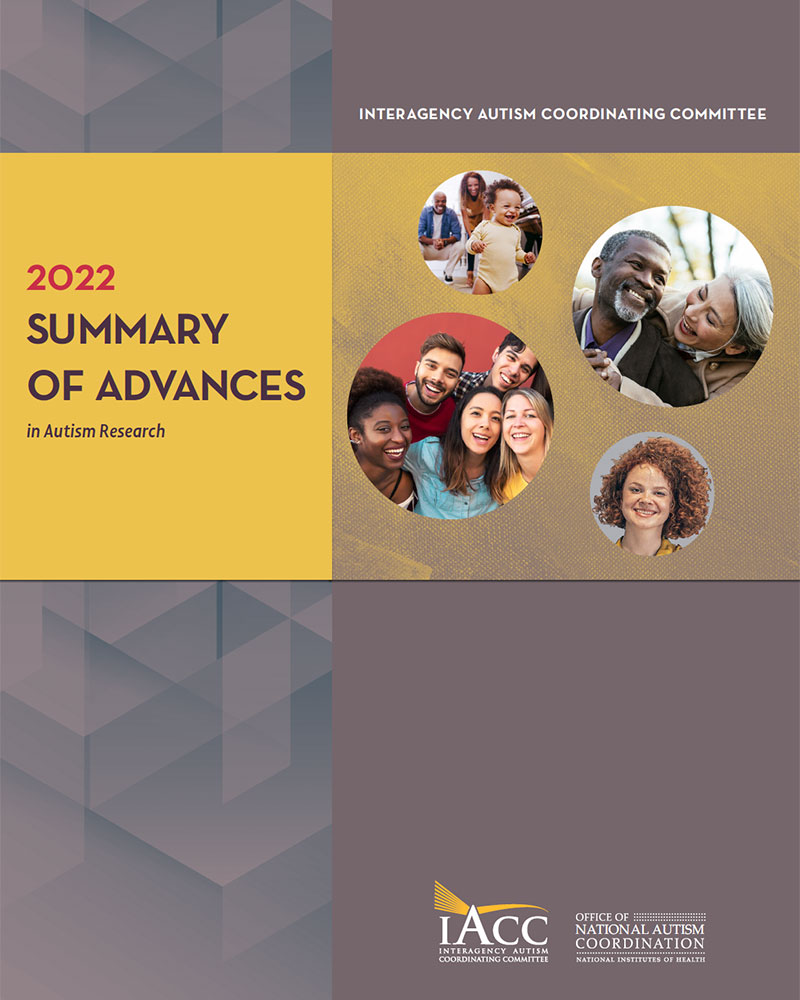Summary of Advances
In Autism Research
2022
Overview
The 2022 IACC Summary of Advances in Autism Research summaries of the top 20 advances in autism biomedical and services research selected by members of the Interagency Autism Coordinating Committee (IACC). Articles in the Summary of Advances are grouped according to the topics represented by the seven Questions of the 2021-2023 IACC Strategic Plan for Autism Research, Services, and Policy (Screening & Diagnosis, Biology, Genetic & Environmental Factors, Interventions, Services & Supports, Lifespan, Infrastructure & Prevalence). In addition, the IACC has released an easy-read version to accompany the 2022 Summary of Advances that uses plain language to summarize the full publication in a brief, accessible format.
Each year, the IACC releases a list of scientific advances that represent significant progress in the field of autism research. The Summary of Advances provides short, plain language summaries of the top research breakthroughs selected by the IACC from a pool of research articles nominated by ... Read more.
Articles Selected for the 2022 Summary of Advances
1) Clinician Diagnostic Certainty and the Role of the Autism Diagnostic Observation Schedule in Autism Spectrum Disorder Diagnosis in Young Children. 2) A Data-Driven Approach in an Unbiased Sample Reveals Equivalent Sex Ratio of Autism Spectrum Disorder-Associated Impairment in Early Childhood. 3) Provider and Caregiver Satisfaction with Telehealth Evaluation of Autism Spectrum Disorder in Young Children During the COVID-19 Pandemic. All articles.
Clinician Diagnostic Certainty and the Role of the Autism Diagnostic Observation Schedule in Autism Spectrum Disorder Diagnosis in Young Children. The Autism Diagnostic Observation Schedule, Second Edition (ADOS-2) test may not be necessary for clinicians to diagnose autism in most children. Read more.
Broad transcriptomic dysregulation occurs across the cerebral cortex in ASD. There are significant differences in the gene activity of autistic versus neurotypical brains, particularly in brain regions involved in sensory and language processing. Read more.
Genetic and Environmental Factors
Associations Between Pregnancy-Related Predisposing Factors for Offspring Neurodevelopmental Conditions and Parental Genetic Liability to Attention-Deficit/ Hyperactivity Disorder, Autism, and Schizophrenia: The Norwegian Mother, Father and Child Cohort Study (MoBa). Genes associated with ADHD, autism, and schizophrenia may also affect prenatal factors such as maternal depression and anxiety during pregnancy, highlighting the need to consider genetic factors when studying effects of the prenatal environment on brain development Read more.
Super responders: Predicting language gains from JASPER among limited language children with autism spectrum disorder. Behaviors such as use of gesture, fine motor skills, and play can help predict how autistic children will respond to an intervention to improve social communication and language, suggesting a strategy to match interventions to those who will benefit the most. Read more.
Disparities in Early Intervention Program Participation by Children With Autism Spectrum Disorder in a US Metropolitan Area, 2006 to 2016. Less than half of the children in New Jersey diagnosed with autism between 2006 and 2016 received early intervention services, and significant socioeconomic and racial/ethnic disparities were observed, underscoring the urgency to address disparities and increase access to early intervention. Read more.
Barriers to healthcare and self-reported adverse outcomes for autistic adults: a cross-sectional study. International survey results indicate several barriers, particularly communicating with providers and sensory challenges in waiting rooms, that may affect autistic adults in scheduling and completing primary care visits, leading to worse health outcomes. Read more.
Progress and Disparities in Early Identification of Autism Spectrum Disorder: Autism and Developmental Disabilities Monitoring Network, 2002-2016. The number of autistic children identified early increased substantially between 2002 and 2016 in the United States, though racial and ethnic disparities remained; analyses suggest median age should not be used to measure progress. Read more.




